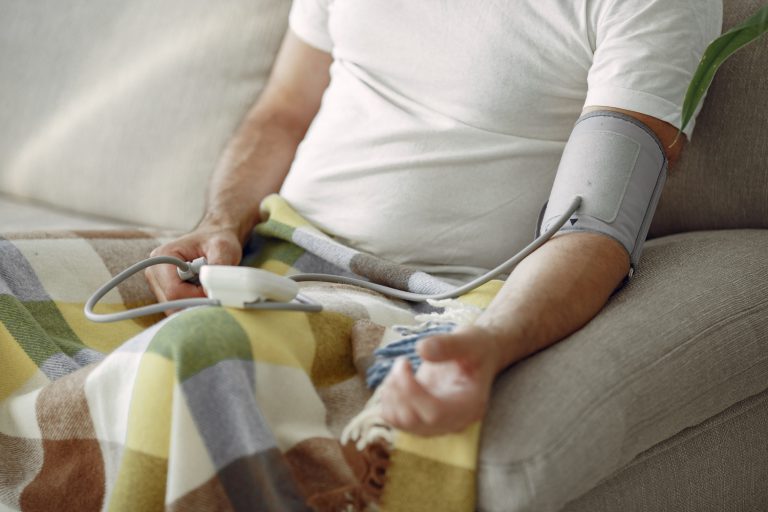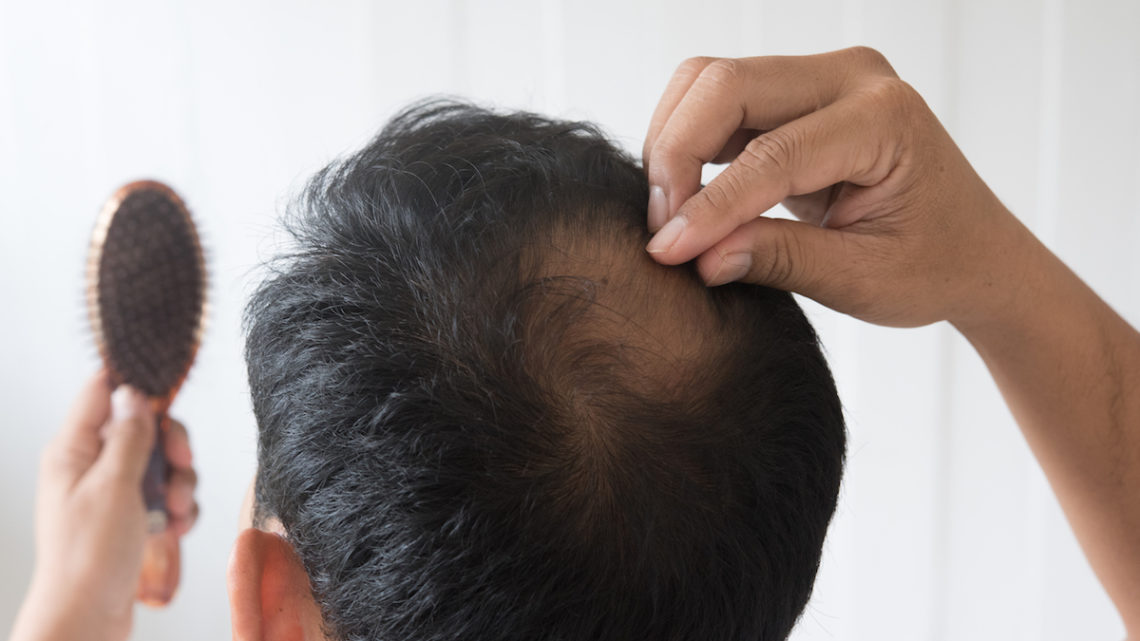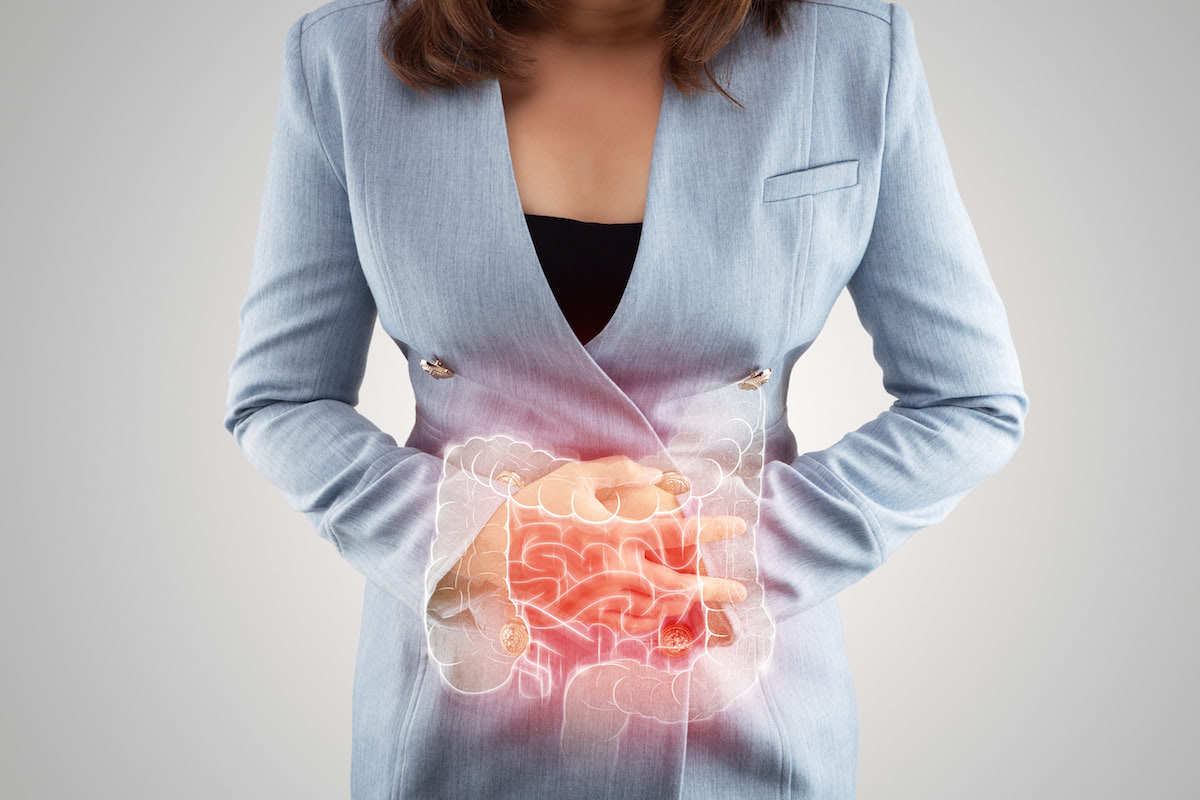Updated on 28. April 2022 from ÁYIO-Q Redaktion
Reading time: approx. 15 minutes
Suddenly the hair falls out – What now?
Hair loss can have various causes and can occur at any stage of life and in any gender. Those affected usually feel alone and unhappy. We discuss what triggers hair loss and how you can fully regenerate your hair again.
People who are affected by hair loss often look in the mirror and no longer recognise themselves. Our hair has a lot to do with our self-image and the image we have of ourselves. When this does not match what we see in the mirror, it leads to dissatisfaction, anger or a loss of self-esteem.
Hair loss is not something you just have to put up with. It is important to recognise what triggers hair loss and what techniques there are to combat it. We will go into this in more detail below.
- Types
- Cycles
- Symptoms
- Causes
- Treat hair loss with vitamins, minerals, and diet supplements
- Treat hair loss with natural oils and other topical remedies
- DHT-Blockers
- Treat hair loss with collagen induction and scalp stimulating therapies
Types, Cycles, Symptoms and Causes of Hair Loss
Types of hair loss
Hair loss, commonly referred to as alopecia, is the loss or thinning of hair in an abnormal manner. The term is often used interchangeably with the simple term “baldness”. It can affect the scalp as well as other hair-bearing parts of the skin, such as:
- beard
- eyelashes
- eyebrows
- armpits
- genital region
Alopecia can be classified into a variety of groups based on its cause and symptoms, but the most common is androgenic alopecia, also known as androgenetic alopecia or pattern baldness, which according to a study accounts for 9.5 in 10 of the cases and primarily affects males, with females being affected less frequently. It gets its name from the action of male hormones or androgens on hair follicles.1
Other frequent types of alopecia include:
- alopecia areata, which causes temporary hair loss in a particular region
- alopecia universalis, which is a widespread variety of alopecia areata
- scarring alopecia, which is caused by the destruction of the hair follicle and therefore irreversible
Hair growth and loss cycles
Human hair grows at a consistent rate: hairs are in various stages of development and rest, and each hair has its own cycle that is independent of those surrounding it. On a daily basis, new hairs develop on the head, while others fall out, in a never-ending cycle.
There are four phases to each cycle: growth, regression, rest and shedding. Hair grows, rests, and falls out in a regular hair cycle to create way for new hair. A daily hair loss of 50 to 100 hairs is considered typical; however, a higher loss may indicate a disruption in the cycle.2

1. Growth or anagen phase
The hair follicle’s growth period is known as anagen. At any one time, approximately 80% of the hair on the scalp is in this phase. These follicles are metabolically active and, as a result, are extremely vulnerable to nutritional alterations and chemical damage: for example, many cancer patients lose the majority of their hair during chemotherapy.
2. Regression or catagen phase
This is the shortest phase of the hair cycle, lasting around 2 weeks on average. At any given time, the number of hair follicles in this phase is relatively tiny. Mitosis in the germinal matrix ends during this phase, and the deepest portion of the follicle shortens and decreases. The inner root sheath disintegrates and vanishes, while the outside root sheath cells form a sac around the germinal matrix. After follicular shortening, the cells of the dermal papilla migrate upward.
3. Resting or telogen phase
Telogen is the hair cycle’s resting phase, with fewer than 20% of the hair at this stage at any given moment. Telogen lasts around three months. When the hair reaches the telogen phase, it stops growing indefinitely. Telogen hair has a “club-shaped” end inside the follicle and falls out either during telogen or the next anagen cycle. In certain cases, telogen hair does not come off, and another anagen hair grows in its place in the same follicle.
4. Shedding or exogen phase
The exogen phase of hair development is simply an extension or component of the telogen stage. Hair is lost from the scalp during the exogen phase, which is frequently aided by washing and combing. New hairs develop in the follicles while old hairs fall out during this stage, which can last anywhere from 50 to 150 days.
Symptoms of hair loss
How can we tell if we’re losing an excessive amount of hair?
There are several signs and symptoms:
- Itching or redness on the scalp
- Frequently finding a large number of hairs on the pillow after waking up
- A lot of hair falling out during brushing and washing
- Dandruff or grease build-up
- Acne or face hair during menstruation
- Hair loss on the crown of the head. Female baldness is characterised by this symptom
- Hair loss on the forehead, temples, or top of the head. This is the most prevalent symptom for males
- Hair loss at a young age, such as in puberty or between the ages of 20 and 30
Causes of hair loss
According to scientific research, hair loss is caused by a variety of reasons, including:
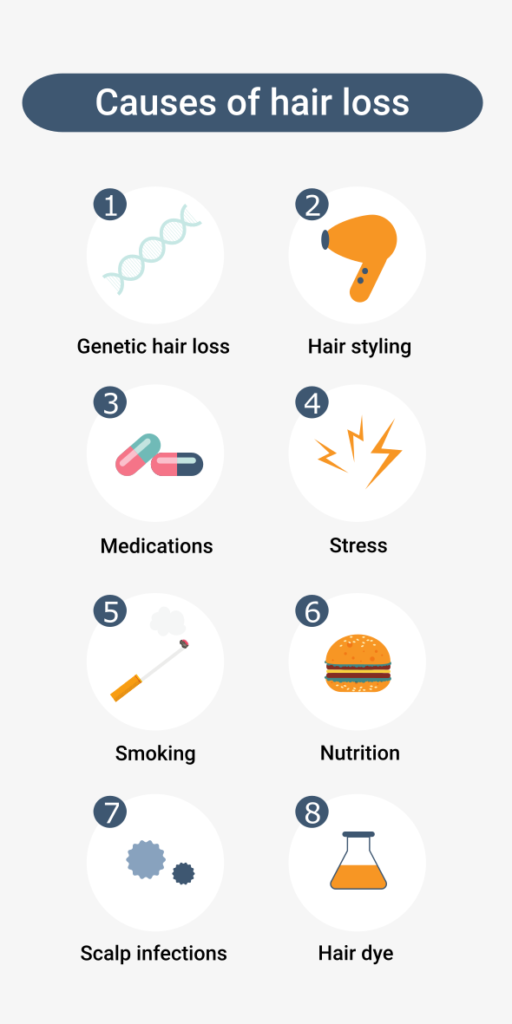
- Hereditary transmissions in which physical and mental traits are passed down from generation to generation through genetics.3
- Physical or mental stress, where most of the hair falls out in a couple of days, particularly on days when people are most anxious.4
- Nutritional deficiencies, essentially a diet that is unbalanced and lacking in minerals, nutrients and vitamins.5
- Use of chemical shampoo and hair dryer in excess. Antibacterial agents, surfactants, and antioxidants are just some of the substances present in many shampoos.6
- Traumatic events and negative infantile experiences, also referred to as trichotillomania (TTM).7
- Medications such as antidepressants8, anticoagulants9, contraceptives10, amongst other drugs.
- Women who have just given birth due to pregnancy and vaginal delivery.11
- Chemotherapeutic and radiotherapeutic agents’ psychologically unpleasant side effects.12
So, how can we successfully combat hair loss?
We will take a closer look at how to prevent and treat hair loss with the help of oral, topical and therapeutic remedies.
How to treat hair loss with vitamins, minerals and diet supplements
Previously, we looked at the different cycles of hair growth. Particularly, the majority of hairs are in the anagen (active growth) phase under normal conditions, whilst only a few in the telogen (resting) phase. In early protein-calorie malnutrition, on the other hand, the contrary is true, which eventually leads to hair loss.
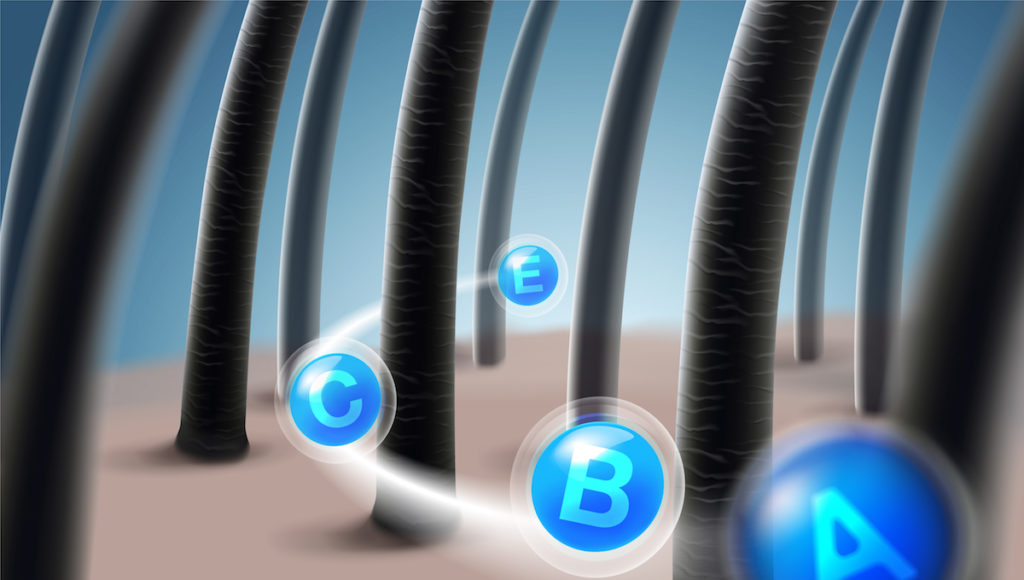
This is why an equilibrated diet plays a fundamental role when it comes to the prevention and treatment of hair loss. Successively we will take a closer look at how to improve or manage nutritional deficiencies or lack of some of the vitamins and minerals.
Vitamin A
Vitamin A is stored, processed, and distributed mostly through the liver. It is ideal for boosting hair shine and preventing hair loss by stimulating the production of sebum, which coats the follicle and improves its texture and reduces the possibility of it becoming brittle. It also aids in the fight against fungal infections and promotes tissue repair.
Good sources of this substance are:
- fruits
- vegetables
- and dairy products
According to a study, for U.S. populations the recommended nutritive intake of vitamin A aimed at individuals aged 19 years or older is 1300 mcg/day (4300 IU [international units]). However, very high amounts of preformed vitamin A (10,000 IU/day) can be harmful to the organism, thus ingesting or supplementing too much of this vitamin can result in hair loss.13
Vitamin B
Eight hydrosoluble vitamin components make up the vitamin B complex, these are:
- thiamine (B1)
- riboflavin (B2)
- niacin (B3)
- pantothenic acid (B5)
- pyridoxine (B6)
- biotin (B7)
- folic acid (B9)
- cobalamin (B12)
Hair loss has only been linked to riboflavin, biotin, folic acid, and cobalamin deficiency.13
Essentially, vitamins in the B group are significant for maintaining healthy hair, skin, and nails. These vitamins promote cell regeneration, which aids metabolic activity and allows one to get the most out of the nutrients consumed. Together, they increase blood circulation, allowing for optimal cell creation, resulting in improved skin, the growth of new hair and tissues, as well as contributing to protein synthesis and regulating the hormone system.
Vitamin B2 (Riboflavin)
Riboflavin is involved in cell regeneration, collagen production, skin stimulation, glucose metabolism, amongst others. Lack of vigour and shine in the hair, peeling of the nails, and lack of radiance in the skin are all symptoms of a lack of this vitamin, which may be found in protein-rich meals.14
Examples of these foods include:
- fish
- nuts
- eggs
- meat
- carrots
- and dairy products
Vitamin B7 (Biotin)
Biotin, also known as vitamin H, is one of the most vital vitamins for maintaining healthy hair and scalp. It contributes significantly to the synthesis of amino acids that make up the protein keratin, which is required for the growth of hair, nails, and skin. The capillaries are restored when biotin is consumed. It not only promotes optimal hair development, but it also strengthens the hair, reducing the appearance of weakness and brittleness therefore preventing hair loss.
The following aliments are all high in vitamin B7:
- bananas
- tomatoes
- brown rice
- strawberries
- and brewer’s yeast
Furthermore, clinical research shows that in 18 recorded instances, biotin supplementation was given to all experimental subjects who had an underlying disease that caused poor hair or nail development. After receiving biotin, all of the individuals exhibited signs of medical improvement.15
The National Institutes of Health recommended Adequate Intakes (AIs) for vitamin B7 are:
| Age | Micrograms |
| 0- 6 months | 5 µg |
| 7–12 months | 6 µg |
| 1–3 years | 8 µg |
| 4–8 years | 12 µg |
| 9–13 years | 20 µg |
| 14–18 years | 25 µg |
| 19+ years | 30 µg |
Vitamin B9 (Folate)
Folate is an essential component for cell development and regeneration because it stimulates hair follicles, thus strengthening the hair and encouraging hair growth. A sufficient amount of vitamin B9 gives hair a fantastic shine and reduces hair loss, preventing the development of premature grey hair.
A nutritious, well-balanced diet can supply your hair with the nutrients it requires to stay healthy and strong. It is crucial to remember that the human body does not store folates/folic acid and that they must be eaten on a regular basis.
Green leafy vegetables contain folic acid, amidst others:
- beans
- avocado
- asparagus
- citrus fruits
- and wholemeal flours
On the report of a study conducted 2014 in India, 29 patients with alopecia aerata that affected more than one-fifth of the scalp, the average red blood cell folate concentrations were considerably lower in the patient group than in the control group, and drastically lower in patients with alopecia totalis/alopecia universalis than in patients with patchy hair loss.16
Vitamin B12 (Cobalamin)
Cobalamin is a nutrient that feeds the body’s cells as well as the hair follicles. It is required for hair growth and to keep its natural colour. In more detail, it is a cofactor for a variety of processes, including DNA replication and red blood cell production.
A cofactor is a molecule or ion that aids in the proper functioning of enzymes. Vitamin B12 deficiency has ramifications for the neurological system, the digestive system, and other bodily functions. Consequently, it can cause hair to alter.
Hair cells’ DNA is responsible for their reproduction and proliferation, and the entire process necessitates an adequate supply of vitamin B12, alongside other nutrients. Therefore, vitamin B12 insufficiency can cause mineral malabsorption, anaemia, and hair loss.
Pregnant women frequently take B12 vitamin supplements, although it can also be found naturally in fermented foods such as:
- tuna
- soya
- fruits
- quinoa
- seaweed
- vegetables
- and dairy products
In 115 individuals with telogen effluvium (TE), a backdated cross-sectional research assessed folate and vitamin B12 both acute and chronic levels. Vitamin B12 insufficiency was found in 2.6 percent of the participants. 17
Vitamin C
Vitamin C, also known as antiscorbutic, is an important nutrient for humans that lack the ability to synthesise it. In fact, it is considered to be a powerful hydrosoluble antioxidant that helps the immune system, reduces and slows the aging process, and improves endothelium integrity and lipoprotein metabolism, including other things as well.
For example, scurvy is an avitaminosis caused by a lack of vitamin C, which is required for human collagen production. Vitamin C deficiency (scurvy) can occur in those who do not eat enough fruits and vegetables, such as the elderly and alcoholics. Follicular hyperkeratosis is the first cutaneous symptom. The hair becomes curly and spiral-shaped (ringlet hair).18
Follicular keratosis is a condition in which the pilosebaceous follicle, which consists of a unit of hair follicle itself, changes and little hard keratin plugs form inside, resulting in rough, red, thick, and flaky skin. The cutaneous organ is the skin, which appears to be a pink, tight, and smooth tissue to the human eye. It is smooth to the touch and has a unique, almost velvety feel to it, given to the small imperfections it contains.
There is not sufficient clinical data to backup that vitamin C levels are inversely proportionate to alopecia, nevertheless the lack of vitamin C is linked to body hair irregularities. Having that said, high vitamin C concentrations can be found in just a few of these vegetables:18
- potatoes
- cabbages
- tomatoes
- citrus fruits
- and green peppers
Vitamin D
Vitamin D is a liposoluble that the body needs to maintain bones strong and healthy. Consequently, the body can only absorb calcium, which is the primary component of bone, if vitamin D is present. In addition, this vitamin promotes the formation of hair follicles, the area of the skin that is responsible for hair growth, making the hair appear stronger and more energetic.
Vitamin D is also involved in a variety of other biological activities in the body, including metabolism, the neurological, muscular, and immunological systems. Its anti-inflammatory, antioxidant, and neuroprotective qualities help to keep the immune system, muscles, and brain cells healthy.
As a result, vitamin D and alopecia are inextricably linked. It is not surprising, however, that a vitamin D deficiency can lead to increased hair loss, first through rupture of the weakening hair strand and subsequently as a type of androgenic alopecia. In our everyday lives, we encounter a variety of circumstances and agents that might impair our skin’s capacity to produce vitamin D, which, amid other things, aids in the prevention of alopecia.
The sun is the most important source of vitamin D, as it aids in the body’s development of this vitamin. After some time in solar contact, the human body produces it spontaneously as a chemical reaction. In most cases, 15 to 20 minutes each day are adequate. Because the body’s production of vitamin D is particularly dependent on exposure to the sun, hair loss due to vitamin D insufficiency is more likely in the winter or in areas with lack of daylight.
Restrictive diets, as already stated, can be the cause of alopecia in many occasions. This condition, referred to as telogen effluvium (TE), is associated to dietary deficits. Therefore food, in addition to sunshine, is a source of vitamin D as well. However, because eating only accounts for roughly 10% of total vitamin D consumption, getting a suitable dosage from it is challenging.19
Vitamin D may be naturally found in a variety of foods, including:
- eggs
- cod liver oil
- intestines (beef liver)
- yeasts and algae, just to name a few
- cheese amongst other dairy products
- and oily fish such as sardines, tuna, mackerel, and salmon
Gade et al. conducted a cross-sectional research to compare blood vitamin D levels in patients with alopecia aerata (AA) to healthy controls, as well as to determine the relationship between vitamin D levels and disease severity in patients with AA. The findings revealed that AA patients have considerable inflammatory reactions and vitamin D insufficiency, which worsened as the condition progressed.20
The National Institutes of Health recommended Dietary Allowances (RDAs) for Vitamin D are:
| Age | Micrograms | International Units |
| 0- 12 months | 10 µg | 400 IU |
| 1–70 years | 15 µg | 600 IU |
| 70+ years | 20 µg | 800 IU |
Although the suggested quantities may seem modest, besides that they vary for most people, a daily vitamin D consumption of 1,000 to 4,000 IU should be enough to keep blood levels healthy. According to the National Institutes of Health, the safe upper limit is 4,000 IU. Please do not exceed this dosage without first checking with a doctor or pharmacist.
Vitamin E
Vitamin E is required for the correct functioning of all cells. In human and animal tissues, it is the most significant fat-soluble antioxidant. It is present in fat-rich tissues and lipid-rich sections of cells like cell membranes. Its primary and most well-studied function is to protect polyunsaturated fatty acids in lipids from oxidative degradation. As a result, a lack of it can have a negative impact on a number of key processes.
One of those vital processes is related to hair health advantages, by maintaining a healthy scalp and hair, as well as having natural antioxidant actions that aid hair development. The antioxidant capabilities of the vitamin can help minimise the amount of oxidative stress and free radicals that cause hair follicle cell disintegration on the scalp.
The following is a short summary of vitamin E’s benefits for hair:
- It aids in the prevention and treatment of hair loss
- It fights dryness in a natural way, leaving hair smooth and silky
- It boosts sebum production, resulting in more moisture in the hair
- Its vital oil components prevent hair breakage by repairing dry and broken ends
- It increases blood flow to the scalp, allowing for improved nutritional absorption and healthier hair
According to Harvard T.H. Chan School of Public Health, plant-based oils, nuts, seeds, fruits, and vegetables all contain vitamin E. Some food sources are listed below:
- mango
- avocado
- almonds
- pumpkin
- asparagus
- wheat germ oil
- sunflower seeds
- bell pepper (red)
- peanuts, peanut butter
- spinach, beet greens, collard greens
- and soybean, sunflower, and safflower oil
The oxidant/antioxidant imbalance has been identified in several clinical investigations in individuals with alopecia aerata, which is a condition characterised by autoimmunity, genetic susceptibility, and emotional and environmental stress. These studies have been evaluated, and the majority of reviewers found that patients with alopecia aerata have higher levels of oxidative stress biomarkers and lower levels of beneficial antioxidant enzymes.21
Iron
Iron is the mineral responsible for producing haemoglobin, which is the protein that transports oxygen to the rest of the body. In particular, iron is involved in energy metabolism, oxygenation, proliferation, and hair development. One of its benefits is that it allows oxygen to be transported to the roots of the hair, thus influencing healthier and stronger hair.
The role performed by iron in the activity of the hair follicle explains the link between iron and hair loss. As a result, when the body’s iron levels are low (ferrotenic anemia), the hair development cycle is disrupted, and hair loss is visible. In this way, iron deficiency, also known as sideropenic alopecia, is a condition that occurs before hair loss due to anemia. Diffuse alopecia is the most common symptom of hair loss due to iron deficiency. Also denominated as acute telogen effluvium (TE), to be precise.
As a result, nutritionists recommend including in the diet foods such as:
- turkey
- quinoa
- spinach
- seafood
- legumes
- red meat
- pumpkin seeds
- liver and other organ meats
Iron deficiency is the most frequent dietary deficit in the world and, as previously mentioned, studies show that it leads to TE. The serum ferritin (iron-binding protein) level is employed as a marker in hair loss research since it is a reliable predictor of total body iron storage. Patients with inflammatory, viral, and neoplastic diseases, as well as those with liver issues, may have increased blood ferritin levels.22
Selenium
Selenium is an element that is only required in trace amounts by the body but is beneficial to overall health. Furthermore, this nutrient plays a role in cell damage prevention. It is required for the formation of antioxidant enzymes, reproduction, thyroid gland function, DNA synthesis, and protection from infection and free radical damage.
Selenium aids the body’s use of all of the protein it consumes, and hair is primarily made up of protein. As a result, whilst the body’s ability to metabolise protein improves, hair growth increases. Selenium therefore promotes hair development while also reducing dandruff. It can help kill Malassezia as well, which is a fungus that grows on the scalp.
Some of the foods that contain selenium are:
- oats
- eggs
- garlic
- beans
- bread
- meats
- sardines
- seafood
- broccoli
- asparagus
- brazil nuts
- cucumbers
- mushrooms
- brewer’s yeast
- and pumpkin seeds
Hair loss and other gastrointestinal symptoms were shown to be significantly reduced in ovarian cancer patients receiving selenium supplementation compared to controls in a clinical research. The authors of the study found that selenium supplementation is a beneficial component of chemotherapy.23
Zinc
Zinc is a trace element that may be found in all of your cells. It is required for the normal functioning of the body’s immune system. It’s important in wound healing and glucose metabolism, as well as cell division and proliferation. Vitamin absorption is aided by it as well. Zinc helps to boost hair growth by improving immune system function.
Zinc helps to slow hair loss and strengthen the hair fibre; it also helps to stimulate hair growth, protects the bulb and prevents further hair loss. By promoting the synthesis of keratin and collagen, it prevents premature hair ageing and protects hair pigmentation. Not only that, but because it is involved in the formation of keratin, which is also an essential protein in nails, it helps to strengthen them.
Good sources of this nutrient include:
- nuts
- beans
- poultry
- red meat
- whole grains
- dairy products
- fortified cereal
- oysters and other seafood
Four out of six case-control studies reported decreased zinc levels in AA patients compared to healthy control groups, according to a review paper on zinc in AA patients. Kil et al. conducted one of these case-control investigations, which included patients with MPHL, FPHL, and ET. The findings of this research revealed a clear link between zinc deficiency and hair loss.24
How to treat hair loss with natural oils and other topical remedies
Essential Oils
Distillation or evaporation are two methods for extracting essential oils from plants. Essential oils are well recognised for their aromatic effects, but they also have potent chemical capabilities that might benefit your health.

Because essential oils are efficient and have few adverse effects, they have long been utilised in alternative, Eastern, and homeopathic treatment. Some essential oils have the added advantage of improving hair health. Diverse oils can help with everything from hair growth to providing strength and luster.
Tea Tree Oil
Due to its antibacterial, bactericidal, and hygienic qualities, tea tree oil is one of the most efficient natural therapies for fungus, lice, and dandruff on the scalp. It moisturises the scalp, decreases baldness, and stimulates hair development by reactivating blood circulation and lowering follicle cell inflammation, all of which are important factors in the production of strong, healthy hair. The outcome is a mane that is thicker, fuller, and healthier.
Treatment
Tea tree oil may be used in a variety of methods to encourage hair growth, including:
- 4 drops tea tree oil to 4 tablespoons olive oil, carefully massaged into your scalp for a few minutes. Allow 30 minutes for your hair to dry before washing it as usual.
- 3-4 times a week, add 5-6 drops of tea tree oil to your usual shampoo and wash your hair with it.
Lavender Oil
Lavender essential oil has been discovered to be beneficial to hair health, particularly in terms of preventing hair loss and promoting hair growth. When applied to the scalp, this oil improves blood circulation and unclogs all clogged pores, allowing hair to begin growing faster and healthier. As a result, this oil is considered one of the most effective natural therapies for alopecia areata. It may also be used to treat dandruff, reduce oil, get rid of lice, and deep condition the hair.
Treatment
It is advisable to dilute a few drops of lavender oil in a little water and massage the mixture into the scalp, working your way down to the ends of the hair, to utilize lavender oil on the hair properly and help it grow quicker than expected. This treatment should be done at night and washed the next morning. For optimum results, repeat 3 times each week.
Peppermint Oil
Peppermint essential oil is amazing for treating dandruff and lowering excess sebum on the scalp, but it’s also a fantastic hair growth essential oil. This is due to its antibacterial characteristics, which maintain the scalp in tip-top shape and keep it healthy at all times, allowing hair to grow as healthy as possible. It also manages to stimulate blood flow in the scalp, ensuring that the hair follicles are well-nourished.
Treatment
The best treatments with this oil are as follows:
- Mix 2 tablespoons of shampoo with about 10 drops of peppermint oil and use this lotion to wash your hair.
- Mix 15 ml of avocado oil with about 6 drops of peppermint oil and apply the mixture to the scalp with a light massage. Leave on for about 15 minutes and then wash your hair as you normally would.
Rosemary Oil
Rosemary oil, which has various advantages for hair health and beauty, is another of the finest essential oils for hair loss that you may use. It primarily aids in the prevention of excessive hair loss by activating capillary irrigation, which substantially strengthens the hair and aids in its quicker and healthier growth. It also works wonders for oily hair and dandruff.
Treatment
You can use the following methods to effectively apply rosemary oil to your hair and benefit from its anti-hair loss properties:
- When the olive oil is warmed, add 2 sprigs of dried rosemary and 5 drops of rosemary essential oil. Apply to moist hair, concentrating on the scalp, and wrap in a towel for 30 minutes.
- Mix around 6 drops of rosemary oil into your usual shampoo and use it to wash your hair.
Bergamot Oil
Bergamot essential oil, which is believed to prevent baldness and stimulate hair development, must be included in any list of essential oils for hair loss. This is due to the presence of vitamin C and other vitamins, which profoundly feed and moisturise the hair, making it stronger and more resistant. It also protects against dryness, enhances the look of greasy hair, avoids dandruff and gives unmanageable hair structure and softness.
Treatment
To encourage hair development, try one of the following bergamot oil treatments:
- 4 drops bergamot oil, 3 or 4 tablespoons almond oil, rubbed for a few minutes into the scalp
- After it has cooled, add 5 drops of bergamot essential oil to a thyme infusion. Massage the mixture into the scalp while wet after washing and let on for 20 minutes before rinsing.
Thyme Oil
If your hair has grown weak and thin, thyme essential oil is a great product to use since its characteristics aid to strengthen and thicken it. On the other hand, because it has the capacity to enhance blood circulation to the scalp, it is effective for stopping progressive hair loss, producing more volume, and boosting growth.
Treatment
Combine the great advantages of thyme oil with those of rosemary oil to produce a more effective hair loss lotion. In a container, combine 6 drops thyme oil and 6 drops rosemary oil, then 6 or 7 tablespoons olive oil. To blend, give it a good shake, then apply to damp hair and massage into the scalp. Allow for a 5-minute cooling period before washing with warm water.
Clinical Studies
A total of 86 subjects with alopecia aerata were randomly assigned to one of two groups. The active group used a blend of carrier oils (jojoba and grapeseed) to massage essential oils (thyme, rosemary, lavender, and cedarwood) into their scalp every day. Only carrier oils were utilised in the control group’s regular massages. Aromatherapy was found to be a safe and efficient treatment for alopecia areata once the experiment was completed. Treatment with these essential oils was far more successful than treatment with only a carrier oil.25
According to a research done by the Société Française de Cosmétologie (SFC), essential oils are also used in hair care products to offer shine and conditioning benefits, as well as preserve and improve the beauty of the scalp. The essential oils of chamomile, rosemary, and West Indian bay assist to condition and promote healthy hair growth. Dandruff can be controlled using bergamot and tea tree essential oils.26
Another medical study confirms bergamot’s effectiveness. From anti-inflammatory and antioxidant processes to therapeutic uses as a preventative agent for cardiovascular mortality, skin diseases, and mental disorders. Bergamot essential oil enhances bone volume, reduces psoriatic plaques, boosts skin collagen content, and stimulates hair development in animal models.27
In addition, a toxicological study done in Korea reveals that peppermint oil increases hair development without causing side effects. The peppermint oil experimental group demonstrated significant hair growth effects in mice, including an increase in the number of follicles, follicle depth, and total hair growth.28
DHT Blockers
What is DHT, exactly?
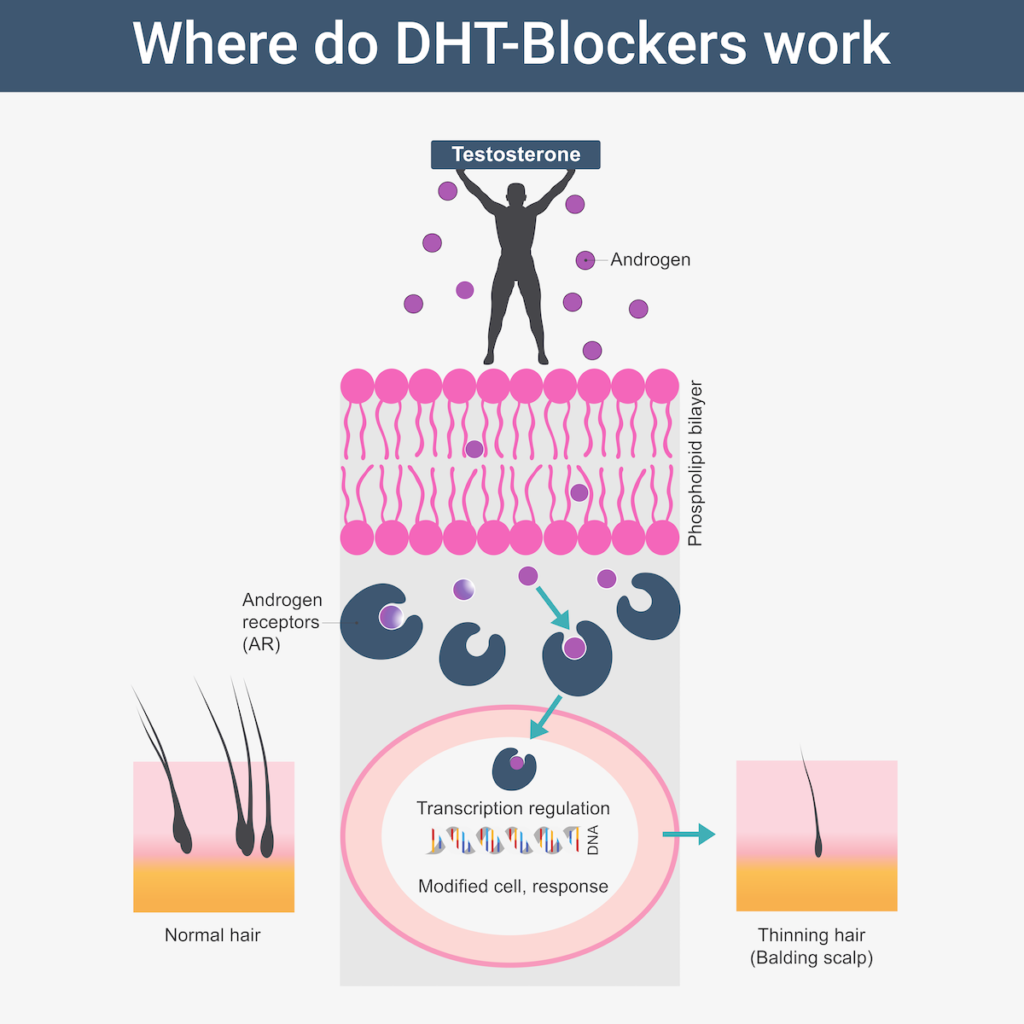
The enzyme 5-reductase catalyses the conversion of testosterone to dihydrotestosterone (DHT). Dihydrotestosterone is an androgen that helps males acquire physical characteristics. DHT is thought to attach to hair follicles, causing them to shrink and so impede or stop hair growth. DHT affects both men and women, however men are more affected than women. By the age of 50, 50% of males will have suffered DHT-related hair loss.
Scientists have been studying the factors that prevent hair loss for the past 20 years. One of the most prevalent and efficient methods is to inhibit DHT in the scalp. The substances mentioned below have been demonstrated to inhibit DHT.
Ketoconazole
Although not natural, the synthetic imidazole possesses antifungal properties and has been clinically demonstrated to prevent testosterone conversion to DHT (dihydrotestosterone). It’s a frequent element in anti-hair-loss shampoos, such as Revita Shampoo.
Clinical trials have shown that ketoconazole is effective in suppressing DHT since 1998. It can also help with inflammation and excessive seborrheic discharge in the scalp.29
When compared to the control region, the area treated with ketoconazole developed more thick hair and had less hair loss, according to a 2005 study.30
Caffeine
DHT (dihydrotestosterone), the major hormone responsible for hair loss, is reversed by caffeine. It is also known to enhance scalp blood circulation and extend the anagen (growth) phase.
Caffeine therapies have been demonstrated to help reduce hair loss by blocking DHT, according to research. Several trials were carried out in the 2020s to treat androgenetic alopecia using caffeine and other substances. According to the findings, using a caffeine-containing therapy is highly recommended.31
Azelaic Acid
Azelaic acid is a dicarboxylic acid that may be found in cereal grains including wheat, barley, and rye. As a result, it is a natural acid. When applied to the skin, it also has a number of advantages. It is used to cure hair loss because of its antibacterial, anti-inflammatory, antioxidant, and depigmenting qualities.
This powerful 5-reductase inhibitor works differently than minoxidil in treating androgenic alopecia by preventing testosterone from being converted to DHT (dihydrotestosterone).
Azelaic acid has also been demonstrated to be useful in the treatment of alopecia areata, a kind of alopecia that is not caused by DHT.32
Saw Palmetto
Another natural substance that inhibits DHT is saw palmetto. It has been demonstrated to aid in the prevention of hair loss and the enhancement of hair look. In a 2001 research, saw palmetto was found to help lower DHT by 32 percent in a herbal combination.33
It blocks androgenic DHT receptors, which helps to battle hormonal hair loss, making it one of the most popular natural substances in hair loss treatments. Palm operates in the same manner as ketoconazole does.
Pumpkin Seed Oil
Natural substances make up several of the most powerful DHT-blocking ingredients. Pumpkin seed oil, for example, has been found to greatly enhance the quantity of hairs. Within six months, there was a 40% increase in hair growth in men with androgenic alopecia, according to research.34
Pumpkin seed oil has been shown to help prevent hair loss, boost hair shine, and preserve hair follicles.
How to treat hair loss with collagen induction and stimulating therapies
Collagen Induction
Collagen induction therapy (CIT), commonly known as micro-needling (MN), is a cosmetic technique that involves puncturing the upper layers of the epidermis with numerous needles to allow therapeutic materials to actively infiltrate the skin. It clears congestion and activates epidermal cells, boosting the skin’s capacity to rejuvenate.
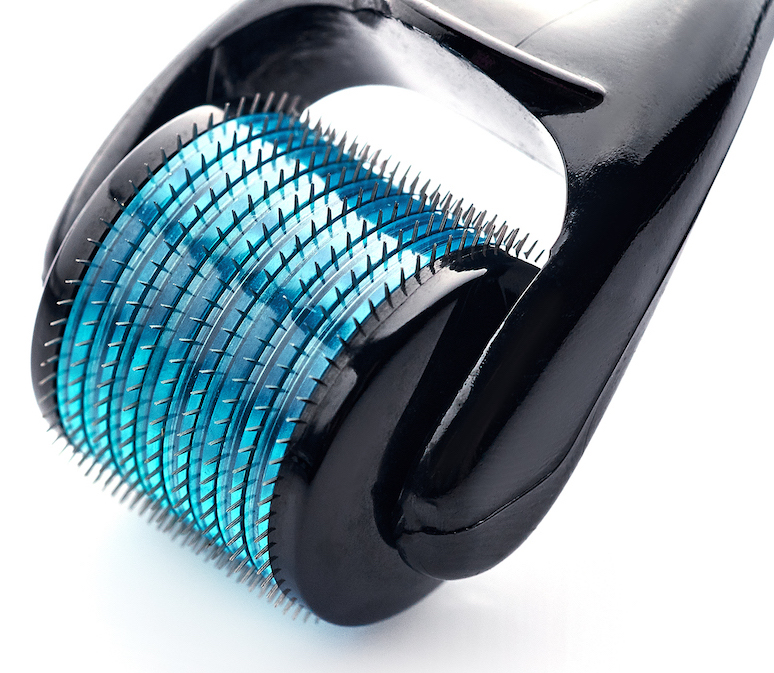
A derma-roller is used to accomplish the procedure. It is a non-invasive alternative to facial plastic surgery, peeling, and laser therapy.
Redness, skin atony, wrinkles, and diminished sensitivity are among the issues addressed by the therapy. Although it is still being studied, it has been used to treat scars and acne. Moreover, micro-needling coupled with minoxidil therapy was shown to be more effective than minoxidil therapy alone in treating hair loss in some trials.35
In addition, micro-needling’s involvement in the therapy of hair pathology is also gaining attention, as it is considered to activate stem cells in the dermal papilla, improve blood flow to hair follicles, and attract growth factors and signalling pathways that cause hair regeneration. This is backed up by the following study.
A Korean research concluded that repeated micro-needle stimulation produces increased hair growth. The goal of this study was to see how hair production and hair growth-related genes were affected by recurrent micro wounds created by a micro-needle in a murine model. Microneedle stimulation can increase hair growth by activating the Wnt/β-catenin pathway and VEGF, according to the findings. The researchers believe that when combined with the medication delivery effect, micro-needle stimulation might lead to new alopecia treatments.36
High Frequency
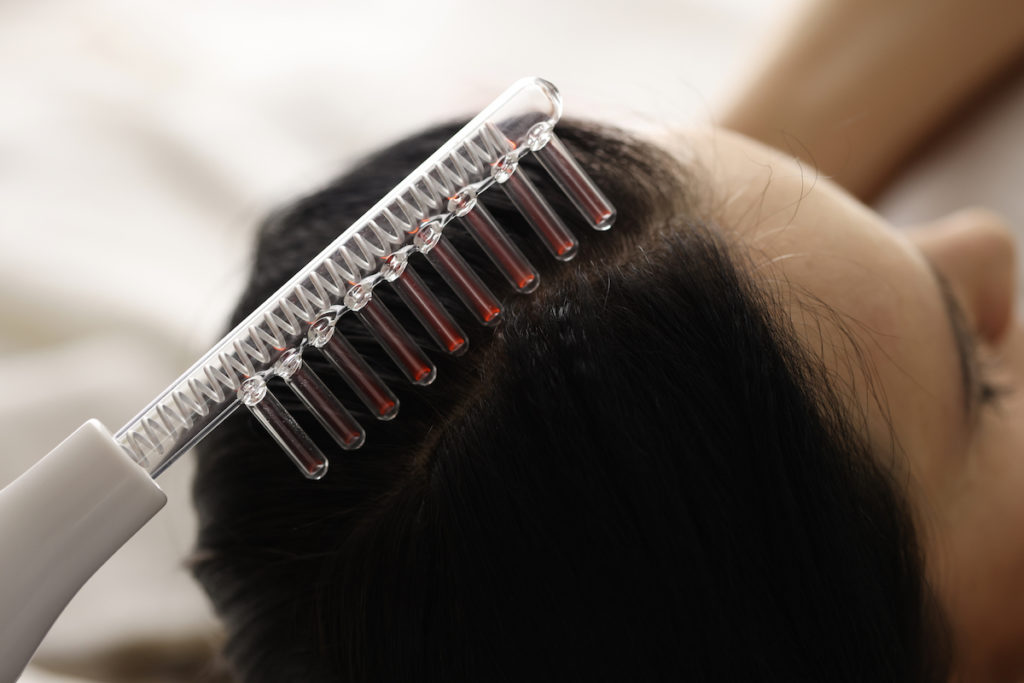
High frequency therapy is effectively a vasodialator, a process that uses electromagnetic waves to promote blood flow on the skin’s surface. The relaxing of the blood vessel’s muscular walls causes the blood vessels to enlarge, allowing for an increased oxygen flow. This can also be used as a hair loss prevention therapy.
Benefits
Some of the electromagnetic advantages include the following:
- Painlessly relieves nerves.
- Promotes metabolism and increases blood circulation.
- Enhances skin secretion, balances PH, and restores skin’s neutral pH.
- Creates ozone sterilisation, which can aid with pain relief and wound healing.
- Improves anti-aging, anti-wrinkle, skin firming, and other functions of the skin.
Applications
Various tubes can be applied to different parts of the body.
- Mushroom Tube for bigger areas of the face, cheeks, forehead, neck, and body skin
- Tongue Tube for face skin has a higher therapeutic impact on the pouches beneath the eyes
- Bending Tube for features like the nasal groove and little sections behind the ear, among other things
- Hair regeneration Comb Tube stimulates the skin’s surface, minimizes folliculitis, and encourages hair growth
- Fork electrode tube for bigger regions such as the arms, legs, necks, and body skin
- Big point massage is appropriate for treating big point acne on the face or body
- Face and body massage roller for skin with a wider surface area on the face and body
Treatments
There are diverse therapeutic methods, some are listed below:
- Indirect method for dry skin nature and aged skin
- Direct method for greasy skin nature
- Sparkle method for skin with sore, inflamed wounds
- Hair care method for stimulating the skin, reducing folliculitis and increasing hair growth
The web content of ÁYIO-Q.com is for your information and in no case replaces a personal consultation or treatment by a qualified physician. The contents of ÁYIO-Q.com cannot and must not be used to make independent diagnoses or for self-medication.
Sources:
[1] David M. Schwartzenfeld, Joseph Karamikian, Chapter 18 – Hair Transplantation, Editor(s): Jeffrey Weinzweig, Plastic Surgery Secrets Plus (Second Edition), Mosby, 2010, Pages 123-127, ISBN 9780323034708. doi: 10.1016/B978-0-323-03470-8.00018-1, at https://www.sciencedirect.com/science/article/pii/B9780323034708000181?via%3Dihub
[2] Cheng AS, Bayliss SJ, “The genetics of hair shaft disorders.” J Am Acad Dermatol 2008;59(1):1-22, at https://www.aad.org/public/diseases/hair-loss/insider/shedding
[3] Hagenaars SP, Hill WD, Harris SE, et al. Genetic prediction of male pattern baldness. PLoS Genet. 2017;13(2):e1006594. Published 2017 Feb 14. doi:10.1371/journal.pgen.1006594, at https://www.ncbi.nlm.nih.gov/pmc/articles/PMC5308812/
[4] Peters EMJ, Müller Y, Snaga W, et al. Hair and stress: A pilot study of hair and cytokine balance alteration in healthy young women under major exam stress. PLoS One. 2017;12(4):e0175904. Published 2017 Apr 19. doi:10.1371/journal.pone.0175904, at https://www.ncbi.nlm.nih.gov/pmc/articles/PMC5397031/
[5] Guo EL, Katta R. Diet and hair loss: effects of nutrient deficiency and supplement use. Dermatol Pract Concept. 2017;7(1):1-10. Published 2017 Jan 31. doi:10.5826/dpc.0701a01, at https://www.ncbi.nlm.nih.gov/pmc/articles/PMC5315033/
[6] Chiu CH, Huang SH, Wang HM. A Review: Hair Health, Concerns of Shampoo Ingredients and Scalp Nourishing Treatments. Curr Pharm Biotechnol. 2015;16(12):1045-52. doi: 10.2174/1389201016666150817094447, at https://pubmed.ncbi.nlm.nih.gov/26278532/
[7] Kara T, Topkarcı Z. Interactions between Posttraumatic Stress Disorder and Alopecia Areata in Child with Trauma Exposure: Two Case Reports. Int J Trichology. 2018;10(3):131-134. doi:10.4103/ijt.ijt_2_18, at https://www.ncbi.nlm.nih.gov/pmc/articles/PMC6028996/
[8] Etminan M, Sodhi M, Procyshyn RM, Guo M, Carleton BC. Risk of hair loss with different antidepressants: a comparative retrospective cohort study. Int Clin Psychopharmacol. 2018 Jan;33(1):44-48. doi: 10.1097/YIC.0000000000000191, at https://pubmed.ncbi.nlm.nih.gov/28763345/
[9] Watras MM, Patel JP, Arya R. Traditional Anticoagulants and Hair Loss: A Role for Direct Oral Anticoagulants? A Review of the Literature. Drugs Real World Outcomes. 2016;3(1):1-6. doi:10.1007/s40801-015-0056-z, at https://www.ncbi.nlm.nih.gov/pmc/articles/PMC4819463/
[10] Hair loss and contraceptives. Br Med J. 1973;2(5865):499-500, at https://www.ncbi.nlm.nih.gov/pmc/articles/PMC1589552/
[11] Cho SI, Yu DA, Kim SI, Lee SM, Kwon O. Pregnancy Outcomes in Female Patients with Alopecia Areata: A Nationwide Population-Based Study. J Invest Dermatol. 2021 Jul;141(7):1844-1847.e4. doi: 10.1016/j.jid.2020.12.014, at https://www.jidonline.org/article/S0022-202X(20)32412-X/fulltext
[12] Saraswat N, Chopra A, Sood A, Kamboj P, Kumar S. A Descriptive Study to Analyze Chemotherapy-Induced Hair Loss and its Psychosocial Impact in Adults: Our Experience from a Tertiary Care Hospital. Indian Dermatol Online J. 2019;10(4):426-430. doi:10.4103/idoj.IDOJ_471_18, at https://www.ncbi.nlm.nih.gov/pmc/articles/PMC6615375/
[13] Almohanna HM, Ahmed AA, Tsatalis JP, Tosti A. The Role of Vitamins and Minerals in Hair Loss: A Review. Dermatol Ther (Heidelb). 2019;9(1):51-70. doi:10.1007/s13555-018-0278-6, at https://www.ncbi.nlm.nih.gov/pmc/articles/PMC6380979
[14] Mahabadi N, Bhusal A, Banks SW. Riboflavin Deficiency. [Updated 2021 Jul 21]. In: StatPearls [Internet]. Treasure Island (FL): StatPearls Publishing; 2021 Jan-, at https://www.ncbi.nlm.nih.gov/books/NBK470460/
[15] Patel DP, Swink SM, Castelo-Soccio L. A Review of the Use of Biotin for Hair Loss. Skin Appendage Disord. 2017 Aug;3(3):166-169. doi: 10.1159/000462981, at https://pubmed.ncbi.nlm.nih.gov/28879195/
[16] Yousefi M, Namazi MR, Rahimi H, Younespour S, Ehsani AH, Shakoei S. Evaluation of Serum Homocysteine, High-Sensitivity CRP, and RBC Folate in Patients with Alopecia Areata. Indian J Dermatol. 2014 Nov;59(6):630. doi: 10.4103/0019-5154.143567, at https://pubmed.ncbi.nlm.nih.gov/25484412/
[17] Cheung EJ, Sink JR, English Iii JC. Vitamin and Mineral Deficiencies in Patients With Telogen Effluvium: A Retrospective Cross-Sectional Study. J Drugs Dermatol. 2016 Oct 1;15(10):1235-1237, at https://pubmed.ncbi.nlm.nih.gov/27741341/
[18] Maxfield L, Crane JS. Vitamin C Deficiency. [Updated 2021 Jul 18]. In: StatPearls [Internet]. Treasure Island (FL): StatPearls Publishing; 2021 Jan-, at https://www.ncbi.nlm.nih.gov/books/NBK493187/
[19] Nair, Rathish, and Arun Maseeh. “Vitamin D: The “sunshine” vitamin.” Journal of pharmacology & pharmacotherapeutics vol. 3,2 (2012): 118-26. doi:10.4103/0976-500X.95506, at https://www.ncbi.nlm.nih.gov/pmc/articles/PMC3356951/
[20] Gade, Venkata Krishna Vamsi et al. “An investigation of vitamin D status in alopecia areata.” Clinical and experimental medicine vol. 18,4 (2018): 577-584. doi:10.1007/s10238-018-0511-8, at https://pubmed.ncbi.nlm.nih.gov/29869122/
[21] Prie, B. E., Voiculescu, V. M., Ionescu-Bozdog, O. B., Petrutescu, B., Iosif, L., Gaman, L. E., Clatici, V. G., Stoian, I., & Giurcaneanu, C. (2015). Oxidative stress and alopecia areata. Journal of medicine and life, 8 Spec Issue(Spec Issue), 43–46, at https://www.ncbi.nlm.nih.gov/pmc/articles/PMC4564047/
[22] Walters, G. O., Miller, F. M., & Worwood, M. (1973). Serum ferritin concentration and iron stores in normal subjects. Journal of clinical pathology, 26(10), 770–772. doi:10.1136/jcp.26.10.770, at https://www.ncbi.nlm.nih.gov/pmc/articles/PMC477879/
[23] Petru, E., Petru, C., & Benedicic, C. h. (2005). Re: “Selenium as an element in the treatment of ovarian cancer in women receiving chemotherapy”. Gynecologic oncology, 96(2), 559–560, at https://www.gynecologiconcology-online.net/article/S0090-8258(04)00788-7/
[24] Kil, Min Seong et al. “Analysis of serum zinc and copper concentrations in hair loss.” Annals of dermatology vol. 25,4 (2013): 405-9. doi:10.5021/ad.2013.25.4.405, at https://www.ncbi.nlm.nih.gov/pmc/articles/PMC3870206/
[25] Hay, I. C., Jamieson, M., & Ormerod, A. D. (1998). Randomized trial of aromatherapy. Successful treatment for alopecia areata. Archives of dermatology, 134(11), 1349–1352. doi:10.1001/archderm.134.11.1349, at https://jamanetwork.com/journals/jamadermatology/fullarticle/189618
[26] Carvalho, I. T., Estevinho, B. N., & Santos, L. (2016). Application of microencapsulated essential oils in cosmetic and personal healthcare products – a review. International journal of cosmetic science, 38(2), 109–119. doi:10.1111/ics.12232, at https://onlinelibrary.wiley.com/doi/10.1111/ics.12232
[27] Perna, S., Spadaccini, D., Botteri, L., Girometta, C., Riva, A., Allegrini, P., Petrangolini, G., Infantino, V., & Rondanelli, M. (2019). Efficacy of bergamot: From anti-inflammatory and anti-oxidative mechanisms to clinical applications as preventive agent for cardiovascular morbidity, skin diseases, and mood alterations. Food science & nutrition, 7(2), 369–384. 25 Jan. 2019, doi:10.1002/fsn3.903, at https://www.ncbi.nlm.nih.gov/pmc/articles/PMC6392855/
[28] Oh, Ji Young, et al. “Peppermint Oil Promotes Hair Growth without Toxic Signs.” Toxicological Research, vol. 30, no. 4, The Korean Society of Toxicology, 31 Dec. 2014, pp. 297–304. Crossref, doi:10.5487/tr.2014.30.4.297, at http://koreascience.or.kr/article/JAKO201402755363070.page
[29] Piérard-Franchimont, C., De Doncker, P., Cauwenbergh, G., & Piérard, G. E. (1998). Ketoconazole shampoo: effect of long-term use in androgenic alopecia. Dermatology (Basel, Switzerland), 196(4), 474–477. doi:10.1159/000017954, at https://www.karger.com/?DOI=10.1159/000017954
[30] Jiang, J., Tsuboi, R., Kojima, Y., & Ogawa, H. (2005). Topical application of ketoconazole stimulates hair growth in C3H/HeN mice. The Journal of dermatology, 32(4), 243–247. doi:10.1111/j.1346-8138.2005.tb00756.x, at https://onlinelibrary.wiley.com/doi/abs/10.1111/j.1346-8138.2005.tb00756.x?sid=nlm%3Apubmed
[31] Völker, J. M., Koch, N., Becker, M., & Klenk, A. (2020). Caffeine and Its Pharmacological Benefits in the Management of Androgenetic Alopecia: A Review. Skin pharmacology and physiology, 33(3), 93–109. doi:10.1159/000508228, at https://www.karger.com/Article/Fulltext/508228
[32] Amirfakhryan, E., Davarnia, B., Jeddi, F., & Najafzadeh, N. (2020). Azelaic acid stimulates catalase activation and promotes hair growth through upregulation of Gli1 and Gli2 mRNA and Shh protein. Avicenna journal of phytomedicine, 10(5), 460–471, at https://www.ncbi.nlm.nih.gov/pmc/articles/PMC7508322/
[33] Marks, L. S., Hess, D. L., Dorey, F. J., Luz Macairan, M., Cruz Santos, P. B., & Tyler, V. E. (2001). Tissue effects of saw palmetto and finasteride: use of biopsy cores for in situ quantification of prostatic androgens. Urology, 57(5), 999–1005. doi:10.1016/s0090-4295(00)01052-9, at https://www.goldjournal.net/article/S0090-4295(00)01052-9/fulltext
[34] Cho, Y. H., Lee, S. Y., Jeong, D. W., Choi, E. J., Kim, Y. J., Lee, J. G., Yi, Y. H., & Cha, H. S. (2014). Effect of pumpkin seed oil on hair growth in men with androgenetic alopecia: a randomized, double-blind, placebo-controlled trial. Evidence-based complementary and alternative medicine : eCAM, 2014, 549721. doi:10.1155/2014/549721, at https://www.ncbi.nlm.nih.gov/pmc/articles/PMC4017725/
[35] Dhurat, R., Sukesh, M., Avhad, G., Dandale, A., Pal, A., & Pund, P. (2013). A randomized evaluator blinded study of effect of microneedling in androgenetic alopecia: a pilot study. International journal of trichology, 5(1), 6–11. doi:10.4103/0974-7753.114700, at https://www.ncbi.nlm.nih.gov/pmc/articles/PMC3746236/
[36] Kim, Y. S., Jeong, K. H., Kim, J. E., Woo, Y. J., Kim, B. J., & Kang, H. (2016). Repeated Microneedle Stimulation Induces Enhanced Hair Growth in a Murine Model. Annals of dermatology, 28(5), 586–592. doi:10.5021/ad.2016.28.5.586, at https://www.ncbi.nlm.nih.gov/pmc/articles/PMC5064188/


